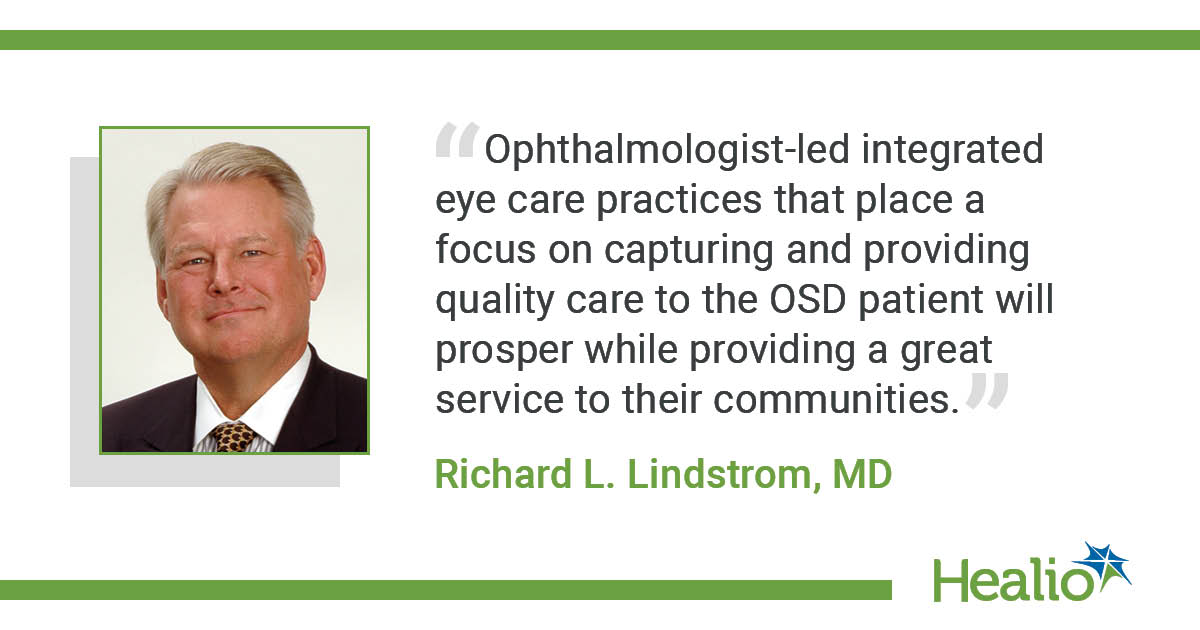Ophthalmologist-led practice may be best model for ocular surface disease treatment
I discussed the projected future U.S. health care system shortage of ophthalmologists in my Lindstrom’s Perspective in the Jan. 25, 2024, issue.
Rounding off, I suggested that we will lose at least 50 clinically active ophthalmologists every year. The HHS data quoted in the current issue’s cover story suggest the loss of practicing clinical ophthalmologists will be even greater, closer to 170 per year.

Every source confirms that the demand for eye care services will increase in the future as the U.S. population ages and we develop more safe and effective treatments requiring the care of an eye care professional (ECP). Sharing just one example, we are entering the era of pharmacologic therapy for progressive myopia, which will require prescription therapy with atropine eye drops for millions of myopic children, ideally starting at age 5 years and potentially continuing through college years. Each of these children and young adults will need to be captured in an ECP office and managed with behavioral modification, optical correction and, for most, daily prescription atropine eye drop therapy. This alone will add several million more office visits to the demand for eye care services every year.
Taking a little license and averaging multiple sources, if we lose 150 clinical ophthalmologists a year, that is 1,500 per decade. The young ophthalmologist finishing training in June 2024 with about 18,000 ophthalmologist colleagues will in 20 years at the peak of their career have only 15,000 practicing ophthalmologist colleagues, and when they retire, only 12,000. The implications of this projection are enormous for society, our patients, our professional organizations, the industry that supports us and each of us individually. These numbers are so dire that it is almost certain that something will and must be done to change them. Training more ophthalmologists is an obvious solution, but so far there is no evidence that this is likely to occur. So, how do we care for a nation’s growing eye care needs in the face of fewer ophthalmologists and continually increasing demand for eye care services per citizen?
One potential solution I have proposed is ophthalmologist-led integrated eye care delivery (OLIED). Of course, integrated eye care delivery can be led by someone other than an ophthalmologist, but ophthalmologists remain the best trained and most appropriate professional to lead an eye care delivery team. However, if we ophthalmologists do not step up and lead, there are many others who will be happy to take our place.
The definition of ECP continues to evolve and is defined by state and federal laws. I define an ECP as a professional who can provide eye care legally and independently bill for it. In my state of Minnesota, that includes ophthalmologists, optometrists, physician assistants and nurse practitioners. An OLIED practice in Minnesota would include at least one ophthalmologist but could include several optometrists and/or PAs or NPs working side by side with the ophthalmologist and other support staff to provide patient care. I believe every ophthalmology practice should employ at least one non-ophthalmologist ECP per MD ophthalmologist, and I have seen practices in which the ratio is as high as 4-to-1.
In this Healio | OSN cover story, the core topic is challenges in the treatment of ocular surface disease (OSD). According to the 1996 American Academy of Ophthalmology-sponsored RAND Study, as many as 40% of patients seen in an ECP’s office practice have one or another OSD. I believe all patients with significant OSD in which there are signs and symptoms deserve to be managed by an ECP. OSD is a perfect example of where the OLIED care model can shine. Patients benefit by having ophthalmologist-led quality care. Ophthalmology practices benefit by capturing a patient population with a lifelong disease that today responds to therapy and is economically viable and attractive. It is time to treat the patient with more than mild and intermittent OSD the same as we do our glaucoma patients. Patients with significant OSD should be captured in an ECP practice, depending on disease severity seen every 3 to 12 months, and followed with appropriate examinations, ancillary testing and, when needed, office-based treatments. For many, it is a challenge to think of OSD like we think of glaucoma, but doing so will alleviate much patient suffering, reduce vision loss and make most ophthalmology practices more economically sustainable in today’s challenging external environment.
Ophthalmologist-led integrated eye care practices that place a focus on capturing and providing quality care to the OSD patient will prosper while providing a great service to their communities.









